Canvas, LTI, and LinkedIn Learning Integration Guide
What this Document Tells You
The following steps outline the LinkedIn Learning and Canvas integration via LTI:
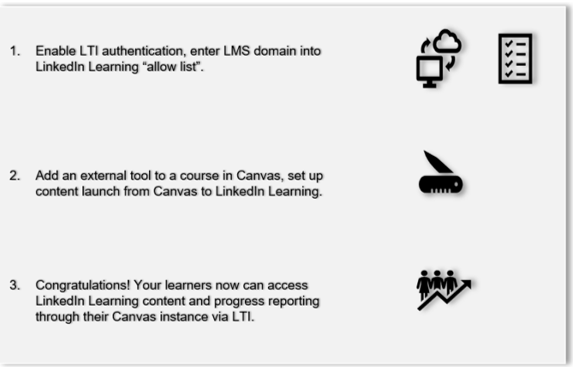
Canvas LTI Overview
LTI is a standardized way of integrating learning applications into learning platforms such as Learning Management Systems, portals, and other educational environments. LTI learning applications (like LinkedIn Learning) are "Tool Providers" and learning platforms are "Tool Consumers".
You can use LTI to authenticate learners from a Tool Consumer into LinkedIn Learning. LTI is based on OAuth 1.0, an open standard for authorization. When a learner selects an LTI Launch URL, the Tool Consumer "POSTs" a signed form with user details to LinkedIn Learning, which uses the form to authenticate and provision the user.
Before Opting for LTI
Since the LTI standard requires an LMS to launch the LinkedIn Learning content, the integration has distinct tradeoffs. Before opting for LTI, please review the sections below to ensure you fully understand the advantages and disadvantages of LTI integrations.
Advantages
If you are a LinkedIn Learning user or admin, you have the following benefits of LTI integration:
Seamless access to LinkedIn Learning for students and instructors
Distinct user experiences for students and instructors
Gradable content
Content easily integrated into LMS courses
Disadvantages
If you are thinking about using the LTI standard in your learning platform, keep in mind the following restrictions:
LTI is not compatible with LinkedIn Learning native mobile applications. These applications include the LinkedIn Learning iOS and Android apps.
To access LinkedIn Learning content, users must have access to your LMS. If a user cannot log into the LMS, the user does not have access to LinkedIn Learning.
Content is only accessible from within the LMS. Educators cannot “deep link” to LinkedIn Learning content on class webpages, wikis, or other external systems.
If your organization uses another form of single sign-on (SSO) with LinkedIn Learning, the SSO connection must use the same unique user ID as your LTI connection to prevent duplicate profiles.
To configure your new LinkedIn Learning account, take the following actions:
Enable LTI Authentication in LinkedIn Learning
You must be a designated LinkedIn Learning administrator to access integration settings. If you are not an administrator, please reach out to your internal LinkedIn Learning lead, and they can add you as an administrator in the system.
Provision LTI Keys
After you log in, if you are not already in the Admin screen, select Go to Admin, then click Me > Authenticate.
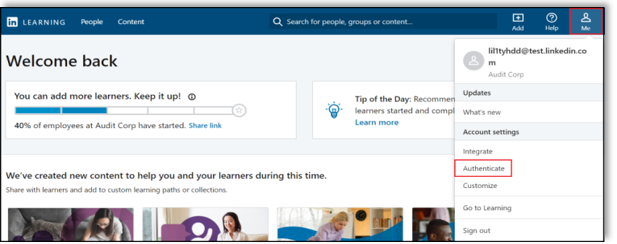
Click Add new SSO and select "LTI".

In the Authenticate users with LTI SSO screen, enter an LTI connection a name in the LTI Connection Name field.
If your LMS does not support Tool Provider-initiated authentication, enter a value in the LMS Login URL field. This value can be your LMS login page or a specific section in your LMS that gives users access to LinkedIn Learning.
Choose whether to automatically provision sub-admin permissions for instructors.
Select which parameter you would like to use to identify users. If you are unsure which value to use, leave User ID.
Important
Ensure the configured User ID value matches the value sent to LinkedIn Learning. If the values do not match, you run the risk of creating duplicate profiles. If you do not know what value to select, contact your LinkedIn Learning Customer Success Manager.
If your LMS supports Tool Provider-initiated authentication, enter your SP-initiated redirect URL. If you do not know which URL to use, leave the field blank.
Click Generate Keys.
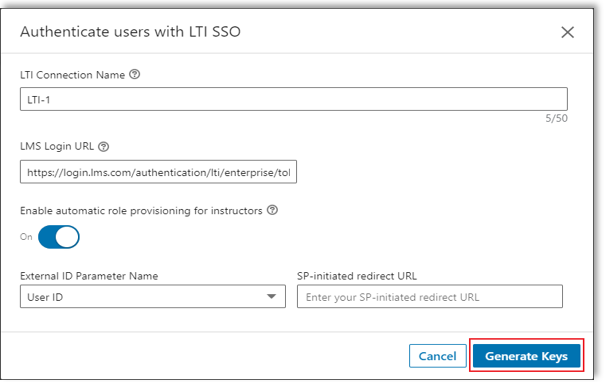
Copy and paste the Consumer Key and Consumer Secret for use in your learning platform and click Save.
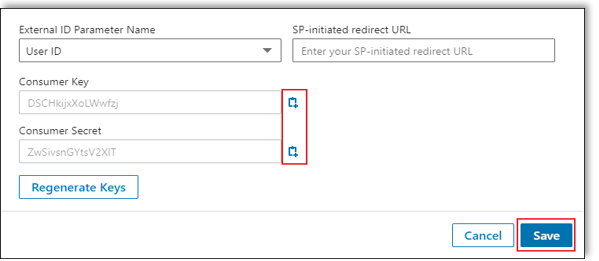
In Authenticate users with this SSO, select "Active".
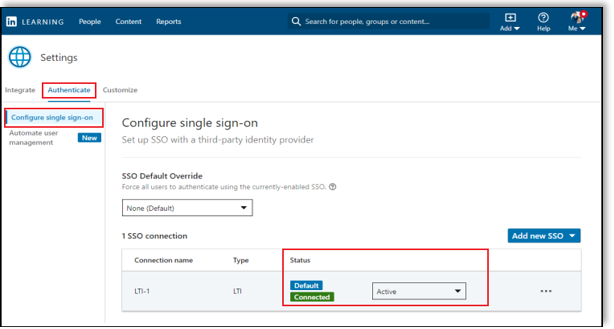
Field Descriptions
The following fields include the settings for provisioning LTI keys:
LMS login
Some Learning Management Systems do not allow direct access to LinkedIn Learning and require users to access learning through the LMS. If this is the case, you can use this field to redirect users who try to access LinkedIn Learning directly. Users can be redirected to the Canvas login page or to a specific section within your LMS if they prefer.
Enable automatic role provisioning for instructors
When you enable this toggle, anyone with the role “Instructor” in your learning platform is automatically provisioned as a sub-admin in LinkedIn Learning. As a sub-admin, instructors can manage, curate, and recommend content.
External ID Parameter Name
Use this setting to determine which authentication attribute is used to identify users. The default value is “User ID”. You also can use “Email Address” or a custom attribute name. For example, your LMS may provide an additional identifier, like lis_person_sourcedid.
SP-Initiated redirect URL
Some Learning Management Systems allow users direct access to LinkedIn Learning.
These learning platforms should offer a tenant-specific "LTI initiation" endpoint to be used by LinkedIn Learning to trigger the LTI authentication flow. If a learner attempts to access LinkedIn Learning content outside of the LMS, the application redirects to the learner's configured "LTI initiation" endpoint for their account. After receiving the redirect, your learning platform prompts the user to authenticate and sends them back to LinkedIn Learning authenticated.
The SP-initiated redirect URL in the LinkedIn Learning settings should be populated with your learning platform’s LTI initiation URL. If this field is not populated or your learning platform does not support this functionality, users can only initiate LTI through your learning platform. Users will not be able to log in to the LinkedIn Learning website directly. If you do not know this URL, consult with your learning management system’s support team or community.
Adding the LMS Domain to the LinkedIn Learning "Allow List"
You need add the LMS domain to LinkedIn Learning "allow list" to ensure successful session configuration. The resulting service URL the LMS provides with the LTI launch must have a domain the LinkedIn Learning "allow list" contains.
To add the LMS domain to the LinkedIn Learning "allow list", take the following steps:
After you log in, if you are not already in the Admin screen, click Go to Admin, then select Me > Integrate.

Select Configure reporting integrations amd expand Configure LTI reporting.
In the Add hostname(s) field enter the domain name of the LMS (i.e.,
www.examplelms.com).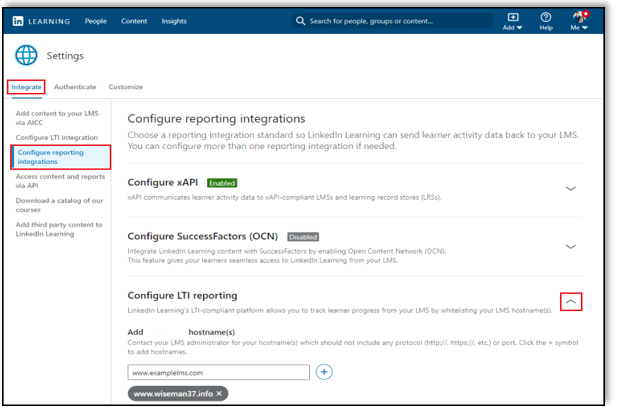
Setting Up an External Tool in Canvas
To set up an external tool in Canvas, take the following steps:
Login to Canvas as an admin.

Go to the Admin > Your account > Settings > Apps and select View App Configurations.
Click + App.
Select "Manual Entry" from the Configuration Type dropdown to create a new LTI configuration that connects Canvas with LinkedIn Learning.
Enter "LinkedIn Learning" as the tool name.
Using the Consumer Key and Consumer Secret values listed under the LTI configuration you set up in the previous step (see:
https://www.linkedin.com/learning-admin/settings/integrations/configure-lti), complete the Consumer Key and the Shared Secret fields.In the Launch URL field, enter this base URL with the format:
https://www.linkedin.com/checkpoint/enterprise/login/[your_account_id]Note
If you don't know your account ID, please reach out to the LinkedIn support team for this value. You should be able to locate the account ID in the browser URL when you are logged in to LinkedIn Learning. Example:
https://www.linkedin.com/learning-admin/settings/global?account=123456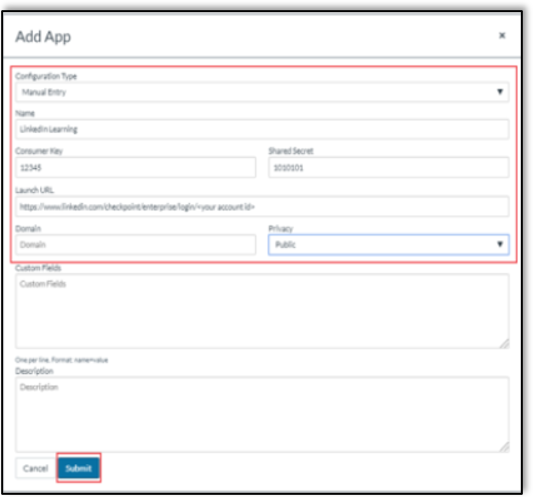
In the Privacy drop down, select your privacy settings.
- Anonymous: No identifying information about the user is sent to the vendor [1].
- Email Only: The user's email is the only identifying information sent to the vendor [2].
- Name Only: The user's name is the only identifying information sent to the vendor [3].
- Public: Various identifying information (name, email, Canvas ID, SIS ID of the course, SIS ID of the user, and so on) is sent to the vendor [4].

Note
We recommend that you select "Public" to ensure Canvas passes all appropriate user attributes back to LinkedIn Learning. This setting allows you to make changes in LinkedIn Learning that the other selections may not permit.
Click Submit.
Adding an External Tool to a Course in Canvas
Next, you need to set up a content launch from Canvas to LinkedIn Learning. To do so, you need an external tool. To add an external tool to a course in Canvas, take the following steps:
Log into Canvas as an admin.
In the left-hand side panel, click Courses, then click the Assignments tab.
Take one of the following actions:
Click an existing assignment under Assignments.
Click + Assignment to create a new assignment.
Set the Points value to "100".
Set Display Grade as "Percentage".

In the Submission Type dropdown, select “External Tool”.
Click Find and select “LinkedIn Learning".
Update the URL to the correct course URL and make sure the Load This Tool in a New Tab checkbox is selected.
The course URL must be the SSO URL, which admins can locate by navigating to a course in LinkedIn Learning, clicking Recommend and copying the SSO URL.
Note
SSO URLs are also available in the course list CSV.
Click Save & Publish.

Congratulations! Your Canvas learners now can access LinkedIn Learning content and reporting via LTI.
Support
Below you can find supporting documentation and other resources.
Supporting Documentation
Technical Issues
If you have technical issues with your multiple SSO configuration, contact your account team or application support team through the LinkedIn Learning Help Center.
LinkedIn's Privacy and Data Security Policy
https://www.linkedin.com/legal/privacy-policy
LinkedIn Security Contacts
If you have any security questions or you would like to report a security issue, write to us at security@linkedin.com.
Questions
If you require further assistance configuring your Canvas instance with LinkedIn Learning via LTI, contact your dedicated LinkedIn Learning Customer Success Manager.
Additional Resources
For more information on integrating LTI v1.1 with your LMS and LinkedIn Learning, see IMS Global’s LTI 1.1 Implementation Guide.
Feedback
Coming soon: Throughout 2024 we will be phasing out GitHub Issues as the feedback mechanism for content and replacing it with a new feedback system. For more information see: https://aka.ms/ContentUserFeedback.
Submit and view feedback for